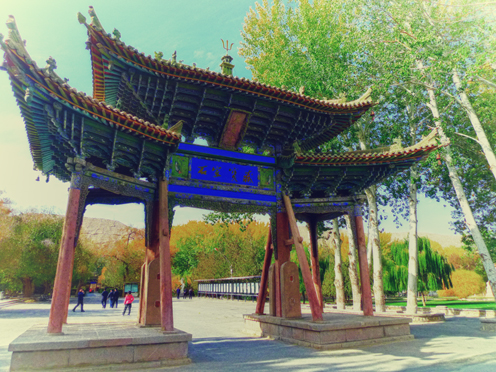We’ve been staying in Dunhuang for 4 days now.
If we were vacationing within a time limit, it would be a bit of a “waste” to spend so much time in a small city. In that sense, we are thankful that we are traveling long term, and so we are able to have a better grasp on our schedule (or the lack of one).
There really is much to see in Dunhuang.
The highlight of Dunhuang is definitely the Mo Gao Caves (莫高窟). In the olden days, Dunhuang was the last city you would see before you set off on a passage across the unforgiving desert, and the first thing you see after you return. Instead of offering incense at a temple like everybody else, the Ancients decided that the best way to get their prayers answered would be to build their own temples. Not just any temple, mind you, but one that is carved into a cave. The result of this is a collection of more than 300 cave temples surrounding a stone mountain in the middle of the desert.

Just outside the fence of Mogao. They built a facade all around the mountain and installed gated doors for each of the caves
An impressive sight in any sense of the word.
But what is more amazing (to us) is the feeling that the Mo Gao Caves are well-loved and fiercely protected. The archaeologists doing the excavation work for the caves double up as guides, and you can tell from their explanations that they really know and care about the treasures within the caves. Visitors are not allowed to wander around the caves on their own and the caves are carefully locked up after each visit. Tour groups are kept small (less than 20) and no photography is allowed once you step through the ENTRANCE. The guides have zero tolerance towards Bad Behaviour.
It’s a pity the same cannot be said about a few of the other Chinese “National Treasures”.
Spitting is a (too) prevalent bad habit among the locals, but it really irks me when I hear the jarring “SCCHHHRRRGGGGJKHJKJKJKJHHHGHGHGJHhhhhh…. PUI!” in a National Park, or worse… a museum (yes, it happened…)

What is inside the caves... Don't worry, I did not sneak a photo. This was taken in a replica cave that was on exhibit.
The Caves themselves were eight shades of awesome. I am no purveyor of fine art (or art of any nature, for that matter), but even I am sufficiently awed by the frescoes and sculptures within the caves.
Perhaps, it was because of the passionate brief given by the archaeologist/guide, we could really see the development of the art within the caves. We were essentially shown 1000 years of art and cultural history of the Dunhuang area within the span of the two-hour tour.
Only ten of the more “significant” caves (out of the thousands) were shown to us, but it was enough to tell us the story of the rise and decline of the Silk Road. Of the fickleness of human nature. Of how something that was so important at one point in history was just forgotten and neglected once something new (sea route trading) comes along.
It was definitely an enlightening side trip and we would highly recommend the detour for anyone coming to the Dunhuang area.


